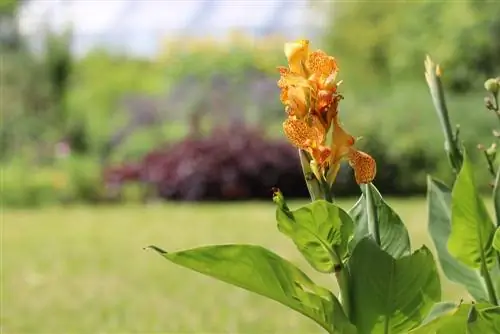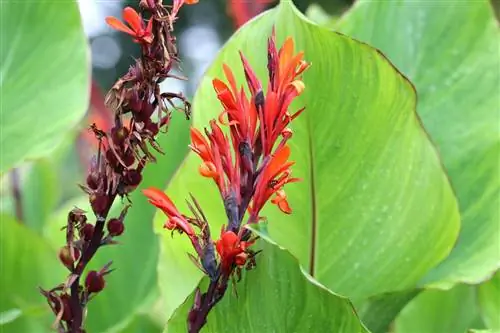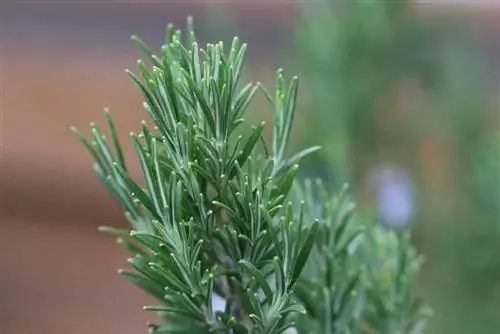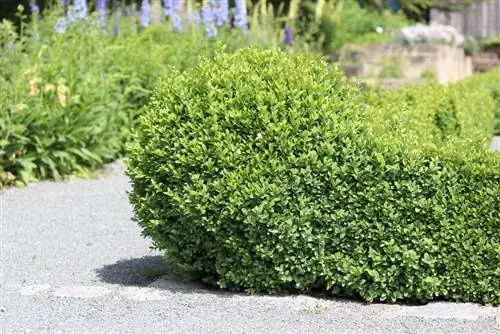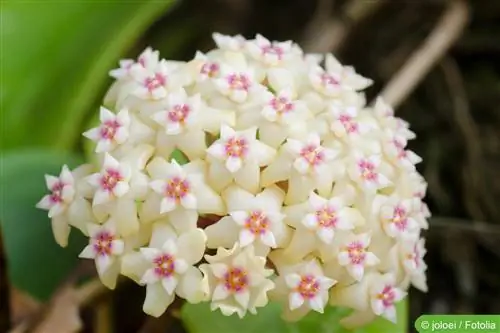- Author admin [email protected].
- Public 2023-12-17 03:39.
- Last modified 2025-06-01 06:48.
A canna's sensitivity to cold is no reason to abandon the tropical flower beauty to its fate after a single season. In fact, all beautiful varieties of Canna indica have the floral persistence of a perennial. It is therefore worthwhile to take a closer look at the right measures for winter storage. This guide details the best strategy for overwintering Indian flower reeds. Find out everything about perfect preparation, the ideal winter quarters and professional care here.
Why canna not tolerate frost?
For generations, the wonderful Canna has been a familiar image when planted out or in pots, it spreads a colorful South Sea flair with its lavish summer flowers in parks and ornamental gardens. This is hardly surprising, as Indian flower cane has been cultivated in Europe since the 16th century. Despite this long history in our regions, the magnificent flower beauty is no match for winter conditions. Canna are native to South America, especially Brazil, Argentina and Colombia, where the annual average temperatures rarely fall below 20 degrees Celsius.
Why is wintering still worthwhile?
Its tropical origins do not mean that Indian cane is limited to a one-year guest appearance in the garden. In its habitat, the plant thrives as a herbaceous perennial that grows wild in the wild. After flowering, the pseudo-stem with the leaves retreats into its strong, up to 60 cm long rhizomes. At the beginning of the next growing season, the canna emerges from its survival organs in order to stage its flower festival again. In the right location and cared for in a species-appropriate manner, the cane plant can grow very old. This habit makes overwintering worthwhile.
Preparatory work
It is not enough to simply put a canna in a pot before winter. In order for the tropical plant to survive the cold season, targeted preparation is important. This means that you can enjoy the magnificent flowering period until October in peace and quiet. Then give the Indian flower tube enough time to shift the remaining nutrients from the pseudostem and leaves into the rhizomes. This process can be recognized by completely wilted flowers and brown-orange discolored leaves and stems. How to properly prepare a Canna indica for overwintering:
- At the beginning of November, shorten the shoots to 5 to 10 cm
- Use a digging fork or small shovel to carefully lift the rhizome out of the soil
- Remove adhering soil with a paint brush or rinse with water
- Cut off damaged, rotten root pieces with a sharp, disinfected knife
- Also remove dried, dead hair roots

There is no cause for alarm if digging involves a creaking noise. The stable rhizomes can cope with the procedure without any problems. Wherever a Canna felt like it was in good hands throughout the summer, its roots have branched out numerous times. You can use this opportunity to divide rhizomes that are too large and thus multiply the plant at the same time. Please dust cuts with a little charcoal ash to disinfect them.
Tip:
The risk of rot and mold in the winter quarters is reduced if you spray the rhizomes with a chinosol solution before putting them away and let them dry long enough. The drug is available in tablet form from pharmacies. Dissolve 1 gram of Chinosol per liter of lime-free water and fill the mixture into a hand sprayer.
Instructions for overwintering in the pot
Put the prepared canna rhizomes out in a shady, airy place to dry for a few days. A grid is well suited as a base so that the roots can dry from all sides. The earth shoots spend the winter dry, cool and frost-free. This is how it works:
- Wrap the rhizomes in several layers of newspaper (not glossy paper)
- Alternatively place in a pot with dry sand, sawdust or straw
- Spend in a dark room with temperatures around 10 degrees Celsius
Since the canna roots are constantly at risk of rot during the winter, please choose a winter quarter that is as dry as possible. Check the rhizomes weekly for brown spots. In the early stages you can cut out small areas of rot and disinfect them with charcoal ash.
To ensure that an Indian flower tube does not sprout prematurely in winter quarters, the thermometer must not exceed the 15 degree mark. If the room in the basement is in the immediate vicinity of the heating system, the heat could become a problem, even though it is dark and dry. A dark, frost-free attic or unlit pantry is more suitable.
Transition from winter to spring
Flower cane rhizomes offer the option of early flowering by pushing the plant forward. For this purpose, a canna is awakened from hibernation during March. This process is comparable to growing tuberous begonias or dahlias. How to proceed:
- Get rhizomes out of winter quarters
- Remove any soil that may be stuck on with a brush
- Pour a mix of 4 parts sand and 1 part leaf compost into a pot
- Insert the rhizomes so deep that they are barely covered with substrate
- Place in a bright, warm location
- At first, only water a little until the first shoots appear
- Water more frequently and fertilize every 14 days in proportion to growth
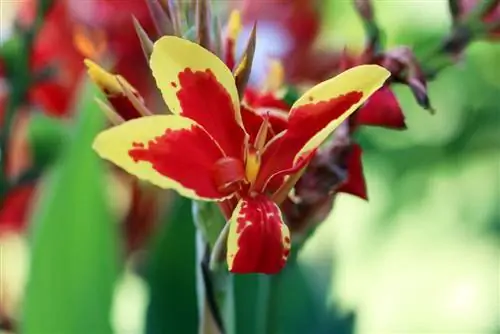
At the beginning/mid of May, pot the plant in its original pot with nutrient-rich substrate. After hardening for 8 to 14 days in a partially shaded location, your Indian flower cane takes a sunny, warm location on the balcony and terrace. Thanks to the vital growth advantage, the waiting time for the flowering period to begin is shortened by at least 2 weeks.
Tip:
The more powerful a rhizome, the more vital it is to survive overwintering. The quality of the pot substrate during the summer growth and flowering period plays a significant role in its vitality. A nutrient-rich compost-based soil is well suited, ideally enriched with well-rotted horse manure.
Overwintering in the bed - This is how it works
In regions within winter hardiness zone Z8, a canna can overwinter in the bed when planted out. The herbaceous parts of the plant die at temperatures below 10 degrees Celsius. The strong rhizomes can withstand temperatures down to -10 degrees Celsius deep in the ground. On the Lower Rhine, in mild river valleys or wine-growing regions, you can save yourself having to put them into winter quarters. Instead, you can accompany the Indian flower cane in the bed through the winter with the following precautions:
- At the beginning of November, cut the plant back to a hand's width above the ground
- Spread a 15 to 20 cm thick layer of mulch on the root disk
- Suitable materials are leaves, brushwood, pine leaves or straw
- Unsuitable materials are stones or gravel
Please note that the measures described are only successful in mild winter landscapes. In the foothills of the Alps, in the low mountain ranges and in eastern Germany, all experiments with wintering in the open air are doomed to failure.
Beautiful varieties
Did these instructions show you how easy it is to overwinter Canna? Then enrich your summer garden with other magnificent flower beauties from this exotic plant genus. The following selection introduces you to classic and new hybrids for pots and beds.
Dwarf canna for the pot
Cleopatra (Canna indica hybrid)
The little beauty rightly bears the name of an Egyptian queen. Its beautiful flowers shine in a warm yellow tone and are decorated with red speckles. The rich green foliage harmonizes perfectly with this play of colors.
Growth height: 50-60 cm

Cherry Red (Canna indica hybrid)
The popular flower tube variety features cherry-red flowers that tower over deep green leaves. Their compact growth and strong stems can also cope with a windy location, which can cause problems for head-sized hybrids.
Growth height: 30-60 cm
Queen Charlotte (Canna indica hybrid)
One of the most beautiful classics within the broad variety family cannot be missing from this selection. The royal Canna enchants with canary yellow, red striped flowers from May to October.
Growth height: 30-60 cm
Evening Star (Canna indica hybrid)
If you are looking for a medium-sized canna, we would like to recommend this variety. Evening Star adds attractive splashes of color in beds and containers with carmine red flowers over lush green leaves. The Indian flower tube is suitable for the large pot on the sunny balcony as well as for a sun-drenched front garden.
Growth height: 60-90 cm
Canna varieties with decorative foliage
Pink Sunburst (Canna indica hybrid)
The spectacular innovation boasts deep pink flowers and pink-green-black-striped leaves. A fantastic eye-catcher for any sunny location in the garden and on the balcony. So much color makes it easy to get over the slightly shorter flowering period from June to August.
Growth height: 100-120 cm
Gold vein (Canna indica hybrid)
Anyone who has been able to experience the floral appearance of this canna will be happy to take the small effort of overwintering it. Goldader does what its name promises. The golden-yellow flowers are accompanied by green-yellow striped leaves. The flowering period extends from July to October. Pre-transmission plants put on their flower dress as early as June.
Growth height: 60-80 cm
Striata (Canna indica hybrid)
This successful breeding combines iridescent orange flowers with light green, dark green, creamy white striped foliage. Anyone who wants an Indian flower tube with a subtle yet decorative color is well advised to go with Striata.
Growth height: 100-120 cm
Majestic canna varieties with privacy function
Tropicanna (Canna indica hybrid)
With its impressive stature, numerous orange flowers and a dense foliage, this giant canna is recommended as a fence-peeper with a privacy function. Of course, the exotic flower also likes to fulfill this task in a large pot on the balcony and terrace. In this case, we recommend an additional support rod and a location protected from the wind.
Growth height: 150-200 cm
Canna Liberte (Canna indica hybrid)
If you want an Indian flower tube with a standard size, this orange-flowering premium variety comes into focus. In the bed, Canna Liberte likes to take on the function of a leading plant or join Tropicanna on the fence, as the most beautiful variant of a boundary
Growth height: 120-180 cm
Conclusion
The exotic flower festival of a canna is not limited to a single season in the pot and bed. If due respect is given to its sensitivity to frost, the South American flowering beauty thrives perennially. However, simply putting the plant in the pot is not enough for successful overwintering. The herbaceous parts of the plant are cut off in late autumn, so that only the rhizomes are removed. In the frost-free, dark winter quarters, an Indian flower cane survives the cold season at temperatures of around 10 degrees Celsius. During this phase, the roots are embedded in dry sand, sawdust, straw or newspaper. If you want to enjoy an extra early flowering period, wake the rhizomes from hibernation in March and grow them in a bright, warm location in a mix of sand and leaf compost. In mild winter gardens, canna rhizomes remain in the ground after autumn pruning, well protected by a thick layer of leaves, brushwood or straw. Cultivation in pots also requires dry wintering behind glass.

